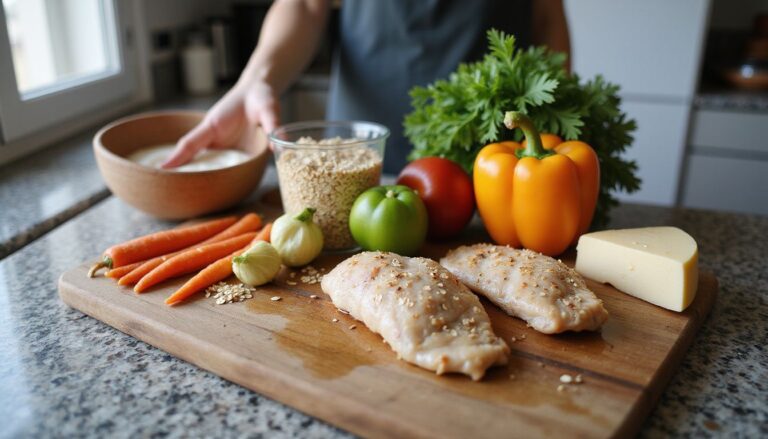Efficient Calorie Intake To Lose Weight: Use A Calorie Calculator To Shed Pounds
Our Nutrition Assistant AI Suite will transform your body. You will lose fat, get toned, and build muscle. Gain confidence and optimal health.
Many people eat less and try new diets yet see little change. Calorie intake matters because a steady calorie deficit, which means eating fewer calories than you burn, helps you lose weight. Using a simple calorie calculator gives you a clear daily target, smarter goals, and food choices that support healthy weight loss.
Start now with practical steps that lead to better, lasting results.
Key Takeaways
- Creating a daily 500 calorie deficit, through eating less or moving more, leads to about 1 pound of weight loss per week (CDC, 2023).
- Calorie calculators use equations like Mifflin-St. Jeor and Harris-Benedict to estimate your needs from age, sex, weight, height, and activity.
- Safe, effective loss is up to 2 pounds per week to protect muscle and metabolic rate (Mayo Clinic; Susan Miller RD).
- Higher protein improves fullness and helps preserve muscle during a cut, as shown in studies by Kohanmoo A, 2020 and Haghighat N, 2021.
- Very low calorie intake, below 1,200 calories for most women or 1,500 for most men, raises risks of nutrient gaps and disordered eating patterns (Stewart TM, 2022).

What Are Calories and How Do They Affect Weight Loss?

Calories are units of energy from food and drinks. If you eat more than your body needs to maintain your current weight, you gain weight. If you reduce calorie intake below your daily burn, you lose weight.
What is a calorie?
A calorie measures the energy in what you eat and drink. Your body uses this energy for every task, from breathing to running. Each macronutrient supplies calories per gram. On average, fat has about 9, protein has 4, carbohydrates have 4, dietary fiber provides about 2, and alcohol has 7 calories.
Foods like fruits, vegetables, grains, lean meats, dairy, and even alcoholic drinks add to your daily intake. Foods that take more chewing and contain fiber, such as raw produce and lean proteins, often help you feel full with fewer calories compared with juices or refined snacks.
“The amount of energy stored in food guides how much you can eat to maintain weight.”
How do calories influence weight loss?
Once you understand calories, the path to weight loss becomes clearer. Your body burns calories all day, even during sleep. Eat above your needs and the excess gets stored as fat. Create a daily deficit and your body taps stored energy instead.
Cutting about 500 calories per day typically leads to a pound a week, since 3,500 calories is a rough estimate for a pound of fat. Large deficits can slow your metabolism and raise the risk of muscle loss. Most adults do best with no more than a 1,000 calorie daily deficit and a loss of no more than 2 pounds per week.
Age, sex, genetics, medical conditions like diabetes or thyroid disease, and physical activity all change how many calories you need. A basic calorie counter can keep you near your daily target without feeling deprived, which protects muscle and supports long term health.
How Can a Calorie Calculator Help You Lose Weight?
A calorie calculator estimates how many calories you need to maintain weight or to create a deficit for fat loss. It gives you a number to guide daily choices, which reduces guesswork and stress.
What is a calorie calculator?
A calorie calculator estimates your maintenance calories using validated formulas. Common ones include Mifflin-St. Jeor, Harris-Benedict, and Katch-McArdle. These use your age, sex, height, weight, activity, and sometimes lean body mass to set a daily calorie target. Good tools keep your entries private and do not store your data.
You can then trim about 500 calories per day to lose roughly a pound per week. That steady pace is easier to follow and safer for most people.
“Understanding your energy intake is key if you want long-term weight loss,” says registered dietitian Susan Miller.
Now see how the calculator turns your basic details into an estimate you can use right away.
How do you estimate your daily calorie needs?
Estimating your needs gives you a starting point for weight loss, maintenance, or gain. A calculator makes the math simple.
- Enter your age, since metabolism often slows with time.
- Add your height, because larger bodies usually need more energy.
- Provide your current weight for an accurate estimate.
- Select your sex, which influences needs due to muscle mass and hormones.
- Choose your activity level, from Sedentary to Extra Active, to reflect daily movement.
- Behind the scenes, the calculator applies scientific equations such as Harris-Benedict to estimate basal metabolic rate, which is the energy you burn at rest.
- Results are often rounded to the nearest 50 calories for easier tracking.
- Pick Calories or Kilojoules based on your preferred unit.
- The output shows what you need to maintain your current weight with your current routine.
Once you have this number, you can set a modest deficit, plan meals, and track progress week by week.
How to Calculate Your Daily Calorie Intake
Your daily needs change with age, sex, body size, and activity. Accurate calorie counting can help you reach and maintain a healthy weight with a balanced diet and regular exercise.
What factors affect calorie needs like age, gender, and activity?
Several factors shape how many calories a day you need to maintain or lose weight. The big three are age, sex, and activity level.
- Age affects your needs because metabolism often slows as you get older. Many adults over 60 need fewer calories than teens or young adults.
- Sex matters. Men often require more energy than women due to higher average muscle mass and body size. Many men need 2,000 to 3,000 calories per day. Many women need 1,600 to 2,400.
- Body size and composition also count. More skeletal muscle increases daily energy burn compared to higher body fat.
- Physical activity raises your calorie burn. Active work and regular exercise can add hundreds of calories to your daily needs.
- Growth phases, including adolescence, require more energy for development. For example, teen boys may need up to 3,200 calories per day.
- Diet type can change energy use. Very low calorie and low carbohydrate plans can trigger fast short term loss for some people.
- Medical conditions such as type 1 diabetes or heart disease may change needs by affecting metabolism or your ability to be active.
- Access to nutritious foods, a social determinant of health, shapes your chance of reaching a healthy weight.
- Hormones also shift energy balance. Puberty, pregnancy, menopause, and some medicines can change hunger and calorie demand.
Adjusting intake for these factors improves results and makes your plan easier to follow.
How to calculate calories for maintaining, losing, or gaining weight?
To manage body weight, estimate your daily burn, then match your intake to your goal. Here is a simple process you can use today.
- Estimate your Basal Metabolic Rate, which is the energy you burn at rest. The Mifflin-St. Jeor equation is common: Men, 10W + 6.25H – 5A + 5; Women, 10W + 6.25H – 5A – 161, where W is weight in kg, H is height in cm, and A is age in years.
- Multiply BMR by an activity factor from 1.2 for sedentary to 1.95 for very active to get maintenance calories.
- To maintain weight, eat about that maintenance number.
- To lose weight, reduce intake by about 500 calories per day for a pound a week. Larger deficits can raise hunger and increase the risk of muscle loss.
- To gain weight or build muscle, add a few hundred calories above maintenance. A sports dietitian can help set a precise surplus.
- Track all calorie sources, including oils, condiments, sweets, and refined snacks that add energy without keeping you full.
- Recalculate if your training, steps, or work routine changes, since needs shift with body composition and activity.
- Use practical targets such as 2,000 calories for maintenance or 1,500 for gradual loss, especially if you manage conditions like high blood pressure or type 2 diabetes.
These steps turn a vague goal into a specific plan you can act on every day.
How to Effectively Manage Calorie Intake for Weight Loss
Managing intake is like budgeting. You decide where to spend your calories so you feel full and still make progress.
How do you create a calorie deficit?
Create a calorie deficit by eating fewer calories than you burn. Many people find that trimming about 500 calories per day leads to steady loss without harsh hunger.
Increase activity to help. Brisk walking, cycling, or strength training adds to your burn, which creates more room in your budget. Use portion control, smaller plates, and pre-portioned snacks to reduce mindless eating.
Calorie cycling, also called zigzagging, can add variety. For example, you might eat 2,300 calories on high activity days and 1,775 on rest days, while keeping the weekly average the same. Track trends over weeks, not just days, so small bumps do not derail progress.
Next, focus on nutrient-rich foods that support fullness and health while you cut calories.
Which nutrient-rich foods support weight loss?
Nutrient dense foods provide vitamins, minerals, fiber, and protein without a lot of added sugar or saturated fat. They help you feel satisfied on fewer calories.
- Choose high fiber fruits such as apples at about 59 calories, bananas at about 151, grapes at about 100 per cup, and tomatoes at about 22 per cup.
- Pick leafy greens like spinach, kale, and romaine. They are low in calories and rich in micronutrients.
- Include lean proteins such as chicken breast, fish, eggs, yogurt, or tofu to support muscle and curb hunger.
- Snack on beans and lentils. They supply protein and slow digesting carbs that steady appetite.
- Stock vegetables such as carrots, broccoli, cauliflower, peppers, and zucchini for volume with few calories.
- Add whole grains like oats or quinoa for steady energy and better blood sugar control.
- Enjoy nuts and seeds in small portions for healthy fats, fiber, and protein that keep you full between meals.
- Drink water throughout the day to support appetite control without adding calories.
These foods make a calorie deficit easier by boosting satiety and nutrition.
What foods should you avoid due to empty calories?
Limit foods and drinks that deliver many calories but few nutrients. Sugary beverages such as soda, sweetened tea, energy drinks, and flavored milk add energy without filling you up. These often account for a large share of added sugar in many diets.
Ultra processed snacks, including chips, crackers, white bread, donuts, candy bars, and pastries, usually pack added sugars and solid fats. Refined carbs like white pasta and sugary cereals spike blood sugar, then hunger returns fast.
Research links high added sugar intake to higher risks of heart disease, diabetes, liver problems, and abdominal obesity. Check labels carefully, since many packaged foods hide added sugars under different names.
What Are the Best Ways to Lower Your Calorie Intake?
Small daily changes add up. Cutting portions, picking water, and choosing lean protein are simple ways to lower your calories per day without giving up taste.
How does increasing protein help reduce calories?
Eating more protein can help you feel full longer. Studies show higher protein intakes reduce appetite and support muscle during weight loss. That means you can eat fewer calories without feeling empty all day.
Protein rich choices include lean poultry, eggs, dairy, tofu, and soy. A 2021 trial found soy based high protein snacks improved appetite control and body composition in women with normal weight obesity. Add protein to breakfast or snacks to curb later cravings.
Why should you increase water intake?
Drinking more water before meals can reduce how much you eat. Research shows that a glass of water before eating helps you feel fuller and lowers energy intake. Hydration also supports brain function and may reduce the chance of kidney stones.
Keep a bottle nearby and take a few sips every hour. Having water before each meal is an easy habit that supports a calorie deficit.
How can cutting sugary drinks lower calories?
Replacing sugary drinks with water, seltzer, or unsweetened tea cuts calories quickly. Liquid sugar does little for fullness, so you often eat the same amount later.
Many sweetened drinks contain 100 to 250 calories per serving. The CDC and recent research link these beverages to higher obesity risk and advise limiting them for better weight management. Swap one large soda per day for unsweetened tea and you could see a change within a couple of weeks.
This single switch makes it easier to create the deficit needed for steady loss and supports healthy patterns like a Mediterranean style diet.
What is the impact of minimizing refined carbs and processed foods?
Cutting refined carbs such as white bread, regular pasta, and sugary snacks helps control appetite. These foods lack fiber, get absorbed quickly, and often leave you hungry again.
Studies show whole grains improve fullness compared with refined grains because they contain more fiber. Ultra processed foods can also disrupt normal fullness signals. If you replace processed snacks with whole or minimally processed foods, daily calorie intake often drops on its own and energy levels improve.
Benefits of Using a Calorie Calculator
A calorie calculator gives you a clear target. You can plan meals, track progress, and adjust based on your results.
How does a calorie calculator help set personal calorie goals?
The calculator uses your age, sex, height, weight, and activity to estimate maintenance calories. Many tools round to the nearest 50 for simple planning. If you mark Active or Very Active, the estimate includes exercise burn.
For a sedentary person, the target might be around 1,800 calories. A very active person could need more than 2,400. You can switch between metric and imperial units as needed. After you see your number, you can choose a small deficit for fat loss without draining your energy for workouts.
How can it improve your food choices?
Tracking your intake teaches you what foods cost in calories. You may notice that a small candy pack is about 220 calories, which could be a large part of your snack budget. This awareness helps you pick lower calorie foods that still deliver nutrients.
Even a few days of logging reveals hidden calories from oils, sauces, and sugary drinks. Cooking at home lets you control ingredients and portions. Many people discover that their snacking adds up fast, which makes planning ahead even more valuable.
How does it support sustainable weight loss planning?
Evidence based formulas like Mifflin-St. Jeor and Harris-Benedict give you an accurate starting point. This helps you avoid eating too little, which can slow your metabolism and make maintenance harder later.
Monitoring trends supports steady progress instead of chasing quick fixes. If your routine or goals change, you can update your target. A registered dietitian can help you meet nutrition needs while you track and adjust for long term results.
What Are Examples of Calorie Intake Plans?
Sample plans offer structure. They keep you within a daily limit so you can use calories as a tool for fat loss.
What does a 2000-calorie daily meal plan look like?
A 2,000 calorie plan usually includes three balanced meals. Breakfast might include two slices of bread at about 75 calories each, a cup of 2 percent milk at about 122 calories, and one medium potato at about 130 calories, totaling close to 650.
Lunch could have one cheeseburger at about 285 calories, a cup of cooked rice at about 206 calories, and a glass of milk to reach around 685. Dinner covers the remaining calories with lean protein, vegetables, and a serving of grain or potatoes, aiming for about 665 calories.
Using known item values makes tracking easier. A calculator helps you stay near your target without guesswork.
What does a 1500-calorie daily meal plan include?
A 1,500 calorie plan features three balanced meals and smart snacks if needed. Breakfast could be one egg, a cup of nonfat yogurt, and fresh fruit for about 350 calories. Lunch might include two ounces of chicken breast with a cup of lettuce and a variety of vegetables for about 550 calories.
Dinner can deliver around 600 calories with grilled fish or chicken, a serving of whole grains, and steamed vegetables. A large egg has about 78 calories, which makes portion tracking simple. This setup builds a safe deficit, since losing a pound requires about 3,500 calories over time.
What is included in a 1200-calorie daily meal plan?
A 1,200 calorie plan is quite low for most adults and should be used with care. If you choose it with medical guidance, you might split your day into breakfast at about 345 calories, lunch at about 450, and dinner at about 405.
Sample items include four ounces of tofu at about 86 calories, a cup of broccoli at about 45, and an orange at about 53. Even a square of dark chocolate, about one ounce at 155 calories, can fit as an occasional treat. A calculator makes portion planning precise so your total stays near your goal.
How Does Exercise Affect Calorie Management?
Exercise helps you burn more calories, which makes a calorie deficit easier to reach without tough restrictions.
How many calories do common exercises burn?
Different activities burn different amounts. Use this table to estimate burn per hour, then adjust your daily intake if needed.
| Exercise | 125 lbs | 155 lbs | 185 lbs |
|---|---|---|---|
| Golf (cart) | 198 | 246 | 294 |
| Walking (3.5 mph) | 215 | 267 | 319 |
| Kayaking | 283 | 352 | 420 |
| Swimming (freestyle, moderate) | 397 | 492 | 587 |
| Running (9 min mile) | 624 | 773 | 923 |
- Calories burned increase as body weight increases.
- Vigorous exercise such as running burns the most per hour.
- Walking and golf are moderate options for lighter days.
- Swimming and kayaking train many muscles and burn steadily.
Tracking these numbers helps you plan meals after a long swim or run. If you use a calorie calculator, you can adjust your intake to match activity for better results. That precision keeps motivation high.
How do you combine diet and physical activity effectively?
Pair a balanced diet with regular movement. Start with a calculator to set maintenance, then create a modest deficit for steady fat loss.
Cardio such as walking and jogging burns calories fast. Resistance training protects muscle while you lose fat. Recent studies report that activity supports fat loss and improves energy, mood, and health markers.
Choose nutrient rich foods and skip sugary drinks. Set clear goals for both food and activity, then track progress weekly. This combined strategy is easier to follow and supports long term health.
What Are the Limitations of Tracking Calories?
Calorie tracking is useful, yet it is not perfect. Knowing the limits helps you avoid common pitfalls.
What risks come with excessive calorie restriction?
Eating too few calories can harm your health. Below 1,200 per day for most women or 1,500 for most men, without medical supervision, you raise the chance of fatigue, poor focus, and more illness. Metabolism may slow in response to very low intake. Over time, muscle loss becomes more likely and nutrients are harder to meet.
Research links strict restriction with higher rates of eating disorders and food obsession. Weight often returns after extreme diets due to metabolic changes and low nutrient intake. If you have a medical condition or take medications, talk with your clinician or a registered dietitian before large changes.
Why is tracking every calorie challenging?
Tracking every bite is hard because labels can be off and absorption varies. Cooking methods change calories available in the final meal. Small things like oils, sauces, and sips add up if you forget to log them.
Energy needs also change with sleep, stress, and daily movement. A calculator provides a solid estimate, but it cannot capture every variation. Aim for consistent habits and weekly trends instead of perfect daily precision.
Frequently Asked Questions
Get quick answers to common questions about calorie intake and weight loss.
What is the recommended calorie intake for weight loss?
Many experts advise losing 1 to 2 pounds per week for safety and consistency. That usually means a daily deficit of about 500 to 1,000 calories. Most adults lose weight on 1,200 to 1,800 calories per day, depending on size and activity.
The Mifflin-St. Jeor equation sets a personal target using age, sex, height, weight, and activity. Men often need more calories than women due to muscle mass. Use a calculator to find your number and plan meals that fit your range.
Is a 1200 calorie daily diet safe?
For most adults, 1,200 calories is very low. Many women need at least 1,200 and many men need at least 1,500 unless a clinician supervises the plan. Very low intake can slow metabolism and cause nutrient gaps, which may stall weight loss and harm well-being.
Choose a level that supports energy, protein, and essential vitamins and minerals. If you feel weak or constantly hungry, consider raising calories and speak with a registered dietitian.
How do calorie needs differ between men and women?
Men usually need more calories than women because of higher average muscle mass and different hormone levels. Women ages 19 to 30 often need 1,800 to 2,400 calories for maintenance. Men in the same range often need 2,400 to 3,000.
Needs decline with age as metabolism slows. Women over 60 commonly need 1,600 to 2,200 calories. Men over 60 commonly need 2,000 to 2,600. Activity level can move these numbers up or down by several hundred calories.
Conclusion
A calorie calculator gives you a clear daily target to lose weight at a steady pace. You estimate your needs, set a small deficit, and choose foods that keep you full on fewer calories. Pair tracking with movement to protect muscle and support health.
Focus on protein, whole foods, and water to reduce empty calories. Update your target as your activity or life stage changes. If you have medical concerns, seek guidance from a clinician or a registered dietitian.
With a simple plan and consistent habits, you can achieve healthy weight loss that fits your life.
FAQs
1. How does a calorie calculator help with efficient calorie intake for weight loss?
A calorie calculator estimates your daily energy needs based on age, sex, height, weight, and activity level. Using this tool helps you set a clear target for daily food energy consumption to create the deficit needed to lose body fat.
2. What is an effective daily calorie deficit for losing pounds safely?
Research suggests that reducing your intake by 500 to 750 calories per day can lead to steady fat loss of about one to two pounds each week. This approach aligns with guidelines from health organizations such as the Centers for Disease Control and Prevention.
3. Can tracking calories improve long-term success in shedding excess body mass?
Studies show that people who monitor their caloric intake are more likely to reach and keep their goal weight compared to those who do not track what they eat. Consistent use of a calorie calculator supports accountability and awareness during the process.
4. Is it necessary to consult a healthcare provider before changing my eating plan or using a calorie calculator?
Consulting a registered dietitian or physician ensures your new dietary strategy meets nutritional needs while supporting safe reduction in stored body tissue. Professional guidance helps tailor recommendations based on individual health status or medical conditions.
Summary:
Using a reliable calorie calculator gives structure when planning meals aimed at reducing total body mass through controlled caloric intake. Setting realistic targets, maintaining consistent records, following evidence-based advice, and seeking expert input all contribute toward healthy progress in reaching desired outcomes.







